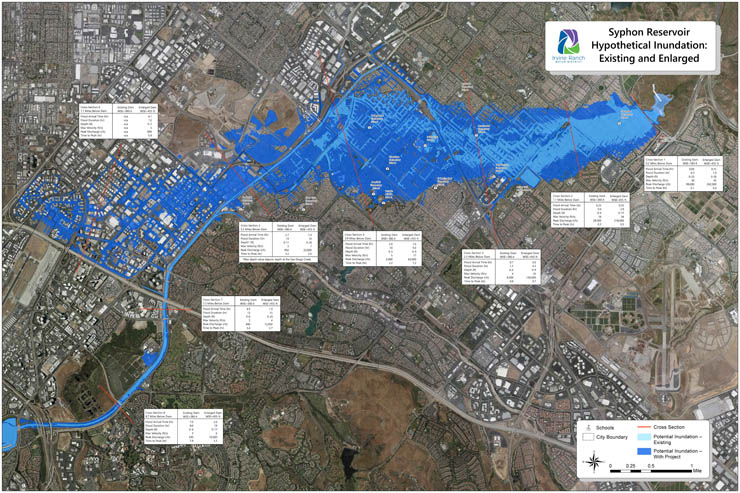Syphon Reservoir Inundation Mapping
What Are Inundation Maps?
Inundation maps are an important part of dam safety practice. An inundation map shows flooding that could result from a hypothetical failure of a dam or its critical components, such as spillways and other outlets. The hypothetical failure scenario that is evaluated typically assumes an instantaneous failure of the entire dam. Information generally provided on these maps includes:
- • Flood boundary lines
- • Flood wave arrival times
- • Maximum water depths
- • Maximum water velocities
Why Are Inundation Maps Prepared?
The need for inundation maps has been established by federal agencies such as the Federal Emergency Management Agency and the U.S. Army Corps of Engineers, and by state agencies such as the California Division of Safety of Dams (DSOD). Under California law, owners of state jurisdictional dams must provide DSOD with a set of inundation studies and prescribed inundation maps. Once approved by DSOD, these maps are incorporated into Emergency Action Plans, which are submitted to the California Governor’s Office of Emergency Services for approval.
What Are the Purposes of Inundation Maps?
- • Dam design. Inundation maps and risk analyses influence the design of the dam by establishing the conditions (such as earthquakes) that the dam will be designed to withstand. The intent is to develop a safe, robust, modern dam design that maximizes the safety of the dam and that avoids failure and downstream consequences.
- • Emergency Action Plan (EAP). Inundation maps serve as one of the six basic elements of an EAP as described in federal dam safety guidelines. EAPs are critical to rapidly identify areas requiring warning and evacuation in the highly unlikely event of a dam or component failure.
- • Hazard classification. Inundation maps provide information to determine hazard classification for dams, following procedures established in federal guidelines for dam safety. The hazard classification is used to determine the level of scrutiny that should be applied to the structure.
- • Risk analysis. Inundation maps are used to identify and understand the potential consequences of a hypothetical dam breach and identify the population at risk, providing valuable context to risk mitigation alternatives.
- • Public awareness. DSOD provides inundation maps on its website to raise public awareness of the presence of a dam near a community and the associated risks. The maps are available at fmds.water.ca.gov/maps/damim/. (On the website, click to enter, then click “OK” on the disclaimer and search for the name of the dam.)
What Are the Limitations of Inundation Maps?
While inundation maps are useful tools, they do have limitations. The inundation studies and maps are hypothetical and are not based on any specific information about the condition of the dam. Therefore, the inundation map itself does not comment on the condition of the dam or public safety. The inundation studies are also based on worst-case scenarios, however remote the likelihood of a failure might be.
Syphon Reservoir Inundation Map
The map below compares the hypothetical inundation zones for Syphon Reservoir — as it is with the existing dam (light blue), and as it would be after completion of the proposed Syphon Reservoir Improvement Project (dark blue). Click map to enlarge.

Safety first: Click here to learn how Syphon Reservoir is designed for safety.
For more information, visit syphonreservoirproject.com, or contact the IRWD Public Affairs department at 949-453-5500 or info@IRWD.com.



